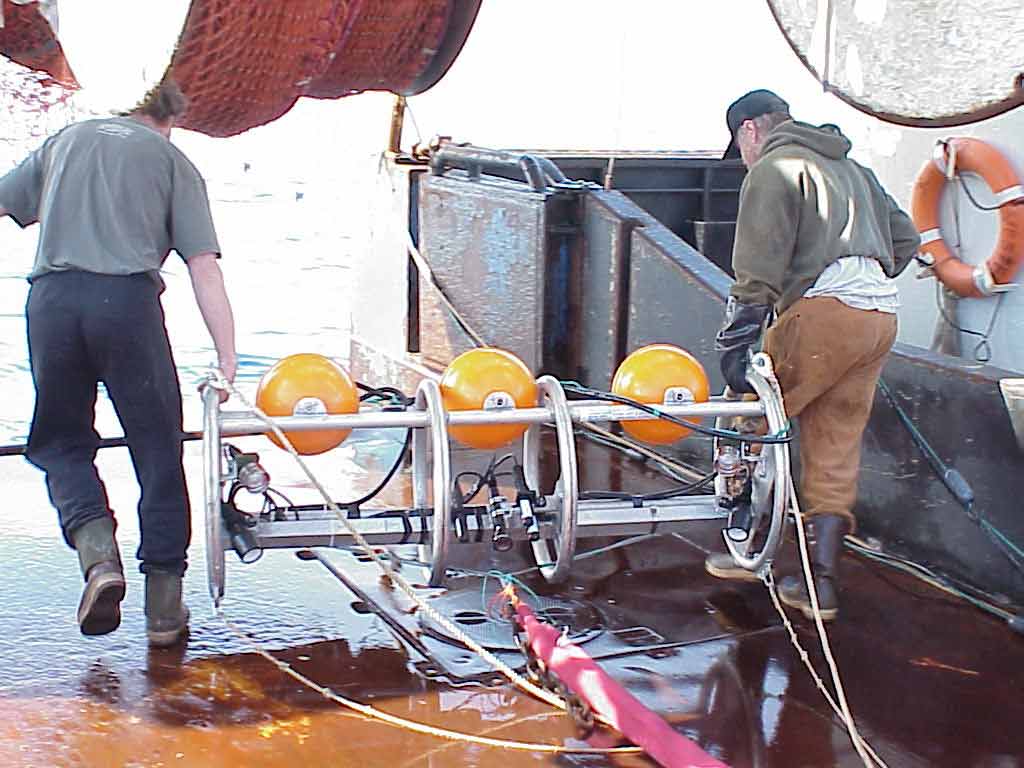 The area around Seguam Pass, which passes between Sequam Island and Amlia Island in the Aleutain chain at approximately 173 degrees longitude, has been fished for decades, and at one point the North Pacific Fisheries Management Council cited it as possibly having experienced significant trawl damage, especially to Gorgonian corals. In response, the RACE Division of the Alaska Fisheries Science Center initiated a study to visually verify the status of that demersal environment. A simple, robust observation platform was required, because the passes that cross the Aleutian Archipelago are notorious for swift currents and very irregular terrain, making the use of submersibles and ROV's impractical. RACE scientists adapted the design for a Towed Automatically Compensating Observation System (TACOS), developed by engineers and scientists at the CSIRO laboratory in Hobart, Tasmania. The apparatus uses a color underwater video camera and AC lighting. Electricity and video signals are transmitted through an electrical tow cable as the camera frame tracks 1-2 meters above bottom. In flat towing attitude, distance above bottom is controlled by counterbalancing flotation with the weight of a drag chain. Live-feed video on the tow vessel's bridge allows the operator to control the amount of deployed cable, responding to changes in the terrain.
The area around Seguam Pass, which passes between Sequam Island and Amlia Island in the Aleutain chain at approximately 173 degrees longitude, has been fished for decades, and at one point the North Pacific Fisheries Management Council cited it as possibly having experienced significant trawl damage, especially to Gorgonian corals. In response, the RACE Division of the Alaska Fisheries Science Center initiated a study to visually verify the status of that demersal environment. A simple, robust observation platform was required, because the passes that cross the Aleutian Archipelago are notorious for swift currents and very irregular terrain, making the use of submersibles and ROV's impractical. RACE scientists adapted the design for a Towed Automatically Compensating Observation System (TACOS), developed by engineers and scientists at the CSIRO laboratory in Hobart, Tasmania. The apparatus uses a color underwater video camera and AC lighting. Electricity and video signals are transmitted through an electrical tow cable as the camera frame tracks 1-2 meters above bottom. In flat towing attitude, distance above bottom is controlled by counterbalancing flotation with the weight of a drag chain. Live-feed video on the tow vessel's bridge allows the operator to control the amount of deployed cable, responding to changes in the terrain.
In August 1999, RACE Division conducted a 14-day cruise aboard the chartered fishing vessel Vesteraalen to gather underwater video footage of the demersal habitat in the Seguam Pass area. The objectives of this study were: 1) examine whether the corals in heavily trawled areas are more damaged and less abundant than in nearby, less trawled areas; and, 2) attempt to verify the extent to which fish and in vertebrates use coral for shelter. Twenty-five successful camera tows were completed. Images were recorded digitally on videotape. The videotapes are currently being reviewed and evaluated at AFSC in Seattle. In general, the study area is extremely varied, ranging from dense "gardens" of benthic invertebrates to large underwater sand dunes. On several occasions what appeared to be Atka mackerel spawning activity on large, offshore rockpiles and pinnacles, was recorded.

